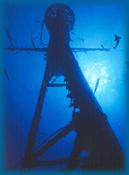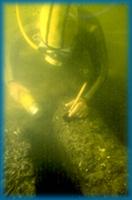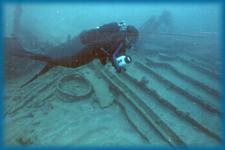|

|
|
USCG Cutter Duane.
Photo courtesy of Florida Keys National Marine Sanctuary.
|
Travelling by water is often easier than travelling over land, but it
is sometimes more dangerous. Weather, warfare, and navigational hazards
and errors have led to countless ship losses, leaving behind a submerged
record of human maritime history. Shipwrecks are time capsules that reflect
the culture and technology of people long ago and offer opportunities to learn
from their successes and failures. As we continue to explore underwater, reaching greater
depths each year, new discoveries reveal more about what happened in history.

|
|
Emanuel Point ship in Pensacola Bay.
Photo courtesy of the Florida Division of Historical Resources.
|
Favorable winds and currents and profitable trade routes have brought hundreds of thousands
of ships to Florida's shores.
War, piracy, hurricanes, and treacherous shoals have
contributed to the loss of several thousand vessels in Florida waters. The coastline
of Florida can be a welcome sight for deepwater mariners. It also is a trap for unlucky
ships. The remains of ships and the cargoes they contain all have a story to tell. The
real treasure of Florida's shipwrecks, however, is in the opportunity they provide for us
to explore the past and preserve it for the future.
Interpretation of historic shipwreck sites, such as those on the Florida Maritime
Heritage Trail, can lead to a better understanding of these unique cultural resources.
Visitors are encouraged to explore the 15 sunken ships on the Trail and to "take only
pictures, leave only bubbles."

|
|
Copenhagen off Pompano Beach.
Photo courtesy of the Florida Division of Historical Resources.
|
Full fathom five thy father lies;
Of his bones are coral made;
Those are pearls that were his eyes;
Nothing of his that doth fade
But doth suffer a sea-change
Into something rich and strange.
- From The Tempest
By William Shakespeare
|












